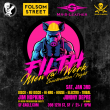By Chad Griffin and Michael J. Kaplan for The Huffington Post.
On the 25th annual World AIDS Day, we note how much the world has changed for LGBT Americans and for all those facing HIV and AIDS. In the early days of the epidemic, as now, advocates committed themselves to raising awareness about this truly global challenge. But today’s advocates have also seized the hopeful and challenging goal of making the next generation an AIDS-free generation. New treatment and prevention programs have made achieving this vision a possibility, but advocates are still battling one of the largest and oldest obstacles in the fight against HIV/AIDS: stigma.
Social stigma, whether it be homophobia in the world at large or HIV-related stigma within the gay community, limits our ability to tackle HIV/AIDS at all levels. This holds particularly true for LGBT Americans. Misinformation — and sometimes outright ignorance — have a negative impact on behavior. Too often the LGBT community itself has reinforced AIDS-related stigma, for example by using labels such as “clean” to refer to those who are uninfected. In addition, anti-LGBT bias breeds fear, causing individuals to hide their sexual identity. These combined forces drive the rising rates of HIV, particularly among young gay men, to alarming levels.
The statistics speak for themselves. Of the 50,000 Americans infected with HIV each year, one in four is between 13 and 24 years old. The overwhelming majority of new infections are among men who have sex with men. The trend is particularly pronounced within the African-American community: Nearly 6 percent of black gay men under age 30 become newly infected with HIV each year.
We’ve got to recommit ourselves as a country to changing the trajectory of this struggle. It cannot be done with scare tactics or outdated techniques, and the calling cards of the early struggle against HIV/AIDS — the images of friends and family members lost to the first few years of the disease, the red ribbons and the AIDS Memorial Quilt — do not have the same emotional resonance with the younger generation as they do with the older one.
Instead, today’s challenge is to tackle stigma head-on. We must address homophobia among youth and within schools, and AIDS-phobic attitudes within our own communities.
Positive images and messages about one’s identity are integral to shaping self-image. As two gay men growing up in small towns, we tirelessly sought such images. In popular culture, in our communities, in the news, we looked for people like us, examples of who we might become. Often, these searches were in vain.
Today’s LGBT youth face a dramatically improved landscape. Thanks to the repeal of “don’t ask, don’t tell,” the approval of marriage equality in nine states and D.C., federal protections against hate crimes and increasingly positive depictions of LGBT people in mass media, today’s LGBT young people are hopeful about the future. Lesbian and gay service members are new role models. Committed LGBT relationships, once hidden away for fear of stigma, are commonplace today, and marriage equality is a growing reality. These messages are essential, informing and educating the next generation of LGBT people that their sexual orientation or gender identity need not be a barrier to living the lives they want to live. In short, they provide hope.
Only a year ago the medical and scientific communities brought us the vision of an AIDS-free generation. But this vision will not be realized until we recognize that HIV does exist within our own community and that each of us must know our status and take action to protect ourselves.
A decade ago the thought of an AIDS-free generation would have been unimaginable. Now the challenge before us is to give the next generation the tools they need to make this vision a reality. We can do this by continuing efforts to dismantle barriers that deter, even briefly, LGBT youth from reaching their full potential. It’s a project on which LGBT and HIV/AIDS advocates should form collaborative partnerships, and, in tandem, we can dismantle the barriers of stigma and discrimination that have made combating this disease needlessly difficult. If we do, our young people will benefit, and a generation that is free of HIV/AIDS will finally be within reach.













